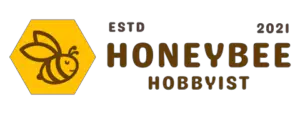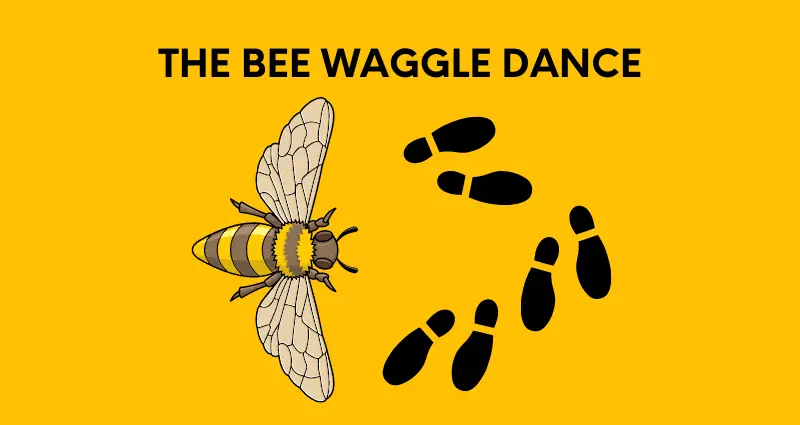The bee dance, also known as the waggle dance, is a communication tool used between worker bees and other colony members. The bee dance is used to share the location of pollen sources, nectar, water, other food sources, threats, and even possible new beehives to call home.
Pollen and nectar are more abundant and available in some specific patches of flowers than in others. So, when a scout bee finds a familiar fragrance and the luscious flower patch, it is her responsibility to communicate where this food source is to the honey bee colony.
But how do they let those bees know where the most extraordinary blooms are?
Honeybees cannot speak, nor are they equipped with maps, cell phones, or other technology. So they must use a different form of communication.
They perform the honeybee waggle dance to share information with their dance follower colleagues in a series of well-coordinated moves.

Inside the hive, bees will use all six of their legs to ‘cut a rug’ on their ‘dance floor’’, and use specific dances to transmit flower location. Other bees watch the dance to learn the instructions for a particular flower patch.
Like a grocery store product demonstrator, the dancing bee, who smells like the floral patch she visited, offers the viewing bees a flavor of the nectar she collected by regurgitating and distributing nectar to bees waiting in the hive.
Other than collecting nectar, the dance is also helpful in gathering information about other hives, home locations, predators, and more.
Bee Dance Discovery
Discovered by Austrian scientist, Karl von Frisch, it was described as “the most astounding example of non-primate communication that we know”.
Von Frisch and other scientists have discovered that the bee dance highlights food sources’ presence, odor, quality, direction, and distance. Specifically, the direction of the food source is evoked by the waggle run’s orientation, while the dance’s length represents the distance information.
The hive mates are apt at decoding this distance and directional information, and several bees will quickly continue their honey bee foraging efforts with this new information.
How Many Types Of Bee Dances Are There?
Communicating information about food sources and locations is done through two basic dance types, the round dance and the waggle dance, plus a transitional form called the sickle dance—the more vigorous the dance, the better the nectar source.
The dances bees do when the honey source is not as good are shorter, less enthusiastic, and less likely to encourage bees to go to that area.
Dance communication can offer information about distance and direction.
Skilled foragers may exchange knowledge about the orientation and proximity of nectar and pollen-producing flowers, water sources, and new nest-site sites with other individuals of the hive by executing this dance. The frenzy of the dance, the length, and the position of the bee’s body all convey information.
Round Dance
The Italian Bee, or Apis mellifera ligustica, does round dancing when a food supply is near the hive (less than 50 to 70 meters or 165 to 230 feet). She does this by sprinting in tight circles before abruptly reversing direction and returning to her previous path.
The bee can repeat the dance multiple times at the same spot or move to a new area to do so. She often offers food to the honeybees following her once the round dance is done. As a result, a circular dance conveys distance (“near to the hive”) but not direction.
Once out of the hive, the worker bees fly in different directions in search of the fragrance the forager emitted and then pick up odors left on the flower from its scent gland.
Waggle Dance: An Informative Figure-Eight
Bees hunting at food sources more than 150 meters from the hive do a waggle dance, also known as a wag-tail dance. However, unlike round and sickle movements, this one conveys both the distance and direction of the food source.
A bee doing the waggle dance flies straight forward for a short distance. She then reverses in a crescent shape to the starting point, flies straight ahead again, and then makes a smooth curve in the other direction to accomplish an entire figure-eight cycle.
The bee’s body, particularly the abdomen, waggles fiercely laterally while running the straight path of the dance. The tail wags as a result of the body vibration. Simultaneously, the bee produces a sequence of buzzing sounds at a short wavelength of 250-300 Hertz (beats per sec).
It has a pulse length of around 20 milliseconds and a frequency repeat of about 30 seconds created by wingbeats. The characteristics of the dance, such as its pace and the duration of the buzzing noises, relate to the distance of the food source.
But, the most uncomplicated and most dependable estimate of distance is the duration of the waggle dance. It measures in seconds. The length of the waggling element in the performance (the “waggle run”) rises as the proximity to the feeding source grows.
It’s an approximately linear connection. For example, a forager doing a 2.5-second waggle run is hunting for a food supply that is roughly 2625 meters distant.
Sickle Dance
The sickle dance is used to acquire food supply at middle ranges from the hive, like 50-150 meters. This dance has the shape of a moon. And it’s a cross between a round movement and a waggle dance.
So now the question is how fast bees can reach these distances… Click here to read our article titled “How Fast Can A Bee Fly? Speeds of Varying Types of Bees.
Is A Bee’s Dance Used To Find A New Hive?
Some biologists theorize the original purpose of the waggle dance was to help bees find a new site.
When a beehive gets congested, it usually separates into two groups. Each of the groups must find a new home. Hundreds of honeybees wait on a tree limb until they locate a cozy and sizable empty tree. They use it as a shelter while a few explorers seek new possibilities.
Every onlooker bee returns to the swarm and performs an unusual waggle dance movement to convey the merits of a specific place. A code indicates the site’s location in this dance.
The bees evaluate the places and assess which of the more highly suggested areas should be the destination of their future home. The relative energy of their dance determines it.
Do All Bees Dance?
Honey bees are the only type of bee that communicates through dance. Only 10 of some 500 types of honeybees use the dance. Why don’t all bees dance?
German bee experts offer some compelling reasons.
The bee dance is time-consuming and lasts up to five minutes; the time it delays worker bees from foraging for food is greater. As worker bees have a short lifespan, time is crucial.
Researchers at Johannes Gutenberg University prevented foraging bees from doing the waggle dance for 18 days and proved what most bee species know: Bees have highly developed senses of smell and taste to help them select the right flower patch. With no dance language, bees went on foraging flights that were 8 minutes long and, over the 18 days, collected 29% more honey.
The team also found that bees who lived in colonies where the waggle dance was common disregarded the information if they decided it was irrelevant and used their intuition to find pollen and nectar.
Individual bee memory may direct the tiny creatures to previously successful sites.
Though bees have been waggle-dancing for 20 (or even 40) million years, the diminishing number of users indicates that the behavior may no longer be useful to most worker bees. Studies have shown that climate and temperature, the time of year, the sun’s direction, gravity, and the availability of food sources affect whether and when bees dance to aid the hive.
Well Done, Honey Bees
Honey bee dancing language provides an excellent example of animal intelligence and communication. Though not all bees, or even all honey bees, do the dance, their communication, perception, intelligence, and ability to adapt to their environment are fascinating.


